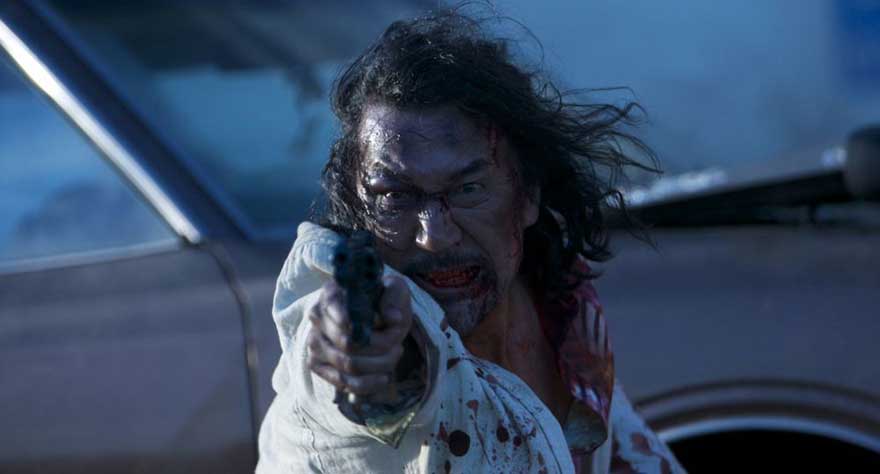
A hyper-frenetic, gripping and horrific descent into emotional depravity.

A hyper-frenetic, gripping and horrific descent into emotional depravity.
Disheveled, substance-addled, and violent, former detective Akikazu Fujishima (Koji Yakusho) stumbles through life in a nebulous haze. His existence is quickly characterized as bumbling and hopeless, but his perpetual floundering is given a vague sense of direction when his ex-wife informs him that their daughter, Kanako (Nana Kamatsu), has disappeared. At first, Akikazu can barely remember her face, but as he unmasks the underworld Kanako appears to inhabit, the will to continue his search stems not from a motivation to find and reunite with her, but to punish her for her wrongdoings, even if that means killing her himself. Sinking deeper and deeper into an abyss of corruption, murder, and sexual deviancy, Akikazu begins to embody the odious patriarchal values of a prior generation. He bloodthirstily yearns to chastise his daughter, perhaps not necessarily in response to her actions, but because of a subconscious self-hatred that has manifested within him after years of neglecting her.
On a surface level, this story sounds glaringly familiar: a broken man embarks on an arduous quest with vengeance in his heart. It’s reminiscent of other, more prominent titles in the so-called “Asia Extreme” genre piloted by acclaimed filmmakers such as Takashi Miike (Audition, 13 Assassins) and Park Chan-Wook, who caused the genre to explode overseas with his popular Oldboy in 2003. This new feature by Japanese provocateur Nakashima Tetsuya (Confessions, Kamikaze Girls) is not only chalk-full of nods to Chan-Wook’s seminal film about an emotionally crippled man assembling the scattered pieces of his past, but also references classic titles such as The Searchers in its Fordian regard to reckless patriarchal rage. While Kanako certainly possesses storyline elements that parallel those at work in Confessions, Tetsuya has abandoned his formalist mise en scène for something more painterly and spontaneous. He goes as far as integrating snippets of anime, clips stylized like J-POP videos, and an opening credits sequence rife with comic book action bubbles into his scattershot visual melting pot.
Where Tetsuya occasionally falters is when he pays too much or too little attention to any given element in his seething ocean of cinematic text. One subplot involves a bullied boy (Hiroya Shimizu) in Kanako’s grade who is credited only as “I,” and serves, more or less, as narrator. The development of his infatuation with Kanako undercuts the impact of the predominant themes related through Akikazu’s presence in the narrative. Reveals along the way help illustrate Kanako’s disturbed mental state, but the victimized narrator is never imbued with much more of a purpose than to aid in manufacturing these developments. Additionally, Tetsuya forgets to punctuate his inclusion of a prowling gang of corrupt cops. They tail Akikazu not prompted by duty, but by an acerbic desire to sneer at his continued failures and injuries. Akikazu, with a persistence that often registers as mythic, is frequently shot, stabbed, and beaten throughout the film. One policeman, the hyena-like Detective Asai (Satoshi Tsumabuki), seems particularly amused by our discombobulated protagonist’s pain. As the film heads into its third act, the assumption can be made that Tetsuya is engineering this subplot in an attempt to make a statement about either Japan’s police force or Akikazu’s demons, but the cackling Asai and his robotic enforcers fade out before making an impression that bears much symbolic weight.
Even throughout sequences where his shortcomings are blatant, Tetsuya maintains a kinetic energy paralleled only by the likes of Sion Sono (who evoked a similarly raucous atmosphere in this year’s street gang musical Tokyo Tribe) and the aforementioned genre film zen master, Takashi Miike. The plot unfolds nightmarishly, fragments of horror unveiling themselves as Akikazu grapples with irremediable patriarchal madness. Koji Yakusho, the veteran actor responsible for bringing Akikazu to life, deserves credit for supplying the story with its anchor. He deftly personifies an antihero who consistently demands our attention and endorsement despite his predisposition to be an unforgivably vile human being. The full realization of Akikazu’s character as the central vantage point allows Tetsuya to indulge in a hyper-frenetic sort of mania without disorienting the audience and causing them to abandon their interest in what he has to offer. The World of Kanako, in spite of its focal faults, is a bracingly spontaneous and grippingly horrific descent into the emotional depravity that has the potential to emerge when family ceases to cohere.